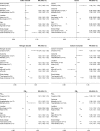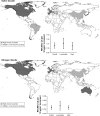Major air pollutants and risk of COPD exacerbations: a systematic review and meta-analysis
- PMID: 28003742
- PMCID: PMC5161337
- DOI: 10.2147/COPD.S122282
Major air pollutants and risk of COPD exacerbations: a systematic review and meta-analysis
Abstract
Background: Short-term exposure to major air pollutants (O3, CO, NO2, SO2, PM10, and PM2.5) has been associated with respiratory risk. However, evidence on the risk of chronic obstructive pulmonary disease (COPD) exacerbations is still limited. The present study aimed at evaluating the associations between short-term exposure to major air pollutants and the risk of COPD exacerbations.
Methods: After a systematic search up until March 30, 2016, in both English and Chinese electronic databases such as PubMed, EMBASE, and CNKI, the pooled relative risks and 95% confidence intervals were estimated by using the random-effects model. In addition, the population-attributable fractions (PAFs) were also calculated, and a subgroup analysis was conducted. Heterogeneity was assessed by I2.
Results: In total, 59 studies were included. In the single-pollutant model, the risks of COPD were calculated by each 10 μg/m3 increase in pollutant concentrations, with the exception of CO (100 μg/m3). There was a significant association between short-term exposure and COPD exacerbation risk for all the gaseous and particulate pollutants. The associations were strongest at lag0 and lag3 for gaseous and particulate air pollutants, respectively. The subgroup analysis not only further confirmed the overall adverse effects but also reduced the heterogeneities obviously. When 100% exposure was assumed, PAFs ranged from 0.60% to 4.31%, depending on the pollutants. The adverse health effects of SO2 and NO2 exposure were more significant in low-/middle-income countries than in high-income countries: SO2, relative risk: 1.012 (95% confidence interval: 1.001, 1.023); and NO2, relative risk: 1.019 (95% confidence interval: 1.014, 1.024).
Conclusion: Short-term exposure to air pollutants increases the burden of risk of COPD acute exacerbations significantly. Controlling ambient air pollution would provide benefits to COPD patients.
Keywords: COPD exacerbations; acute exposure; air pollution; meta-analysis.
Conflict of interest statement
The authors report no conflicts of interest in this work.
Figures




References
-
- Berend N. Contribution of air pollution to COPD and small airway dysfunction. Respirology. 2016;21(2):237–244. - PubMed
-
- Lopez-Campos JL, Tan W, Soriano JB. Global burden of COPD. Respirology. 2016;21(1):14–23. - PubMed
-
- Garcia-Aymerich J, Monsó E, Marrades RM, et al. Risk factors for hospitalization for a chronic obstructive pulmonary disease exacerbation. Am J Respir Crit Care Med. 2001;164:1002–1007. - PubMed
-
- Hawkins NM, Virani S, Ceconi C. Heart failure and chronic obstructive pulmonary disease: the challenges facing physicians and health services. Eur Heart J. 2013;34(36):2795–2803. - PubMed
Publication types
MeSH terms
Substances
LinkOut - more resources
Full Text Sources
Other Literature Sources
Medical

